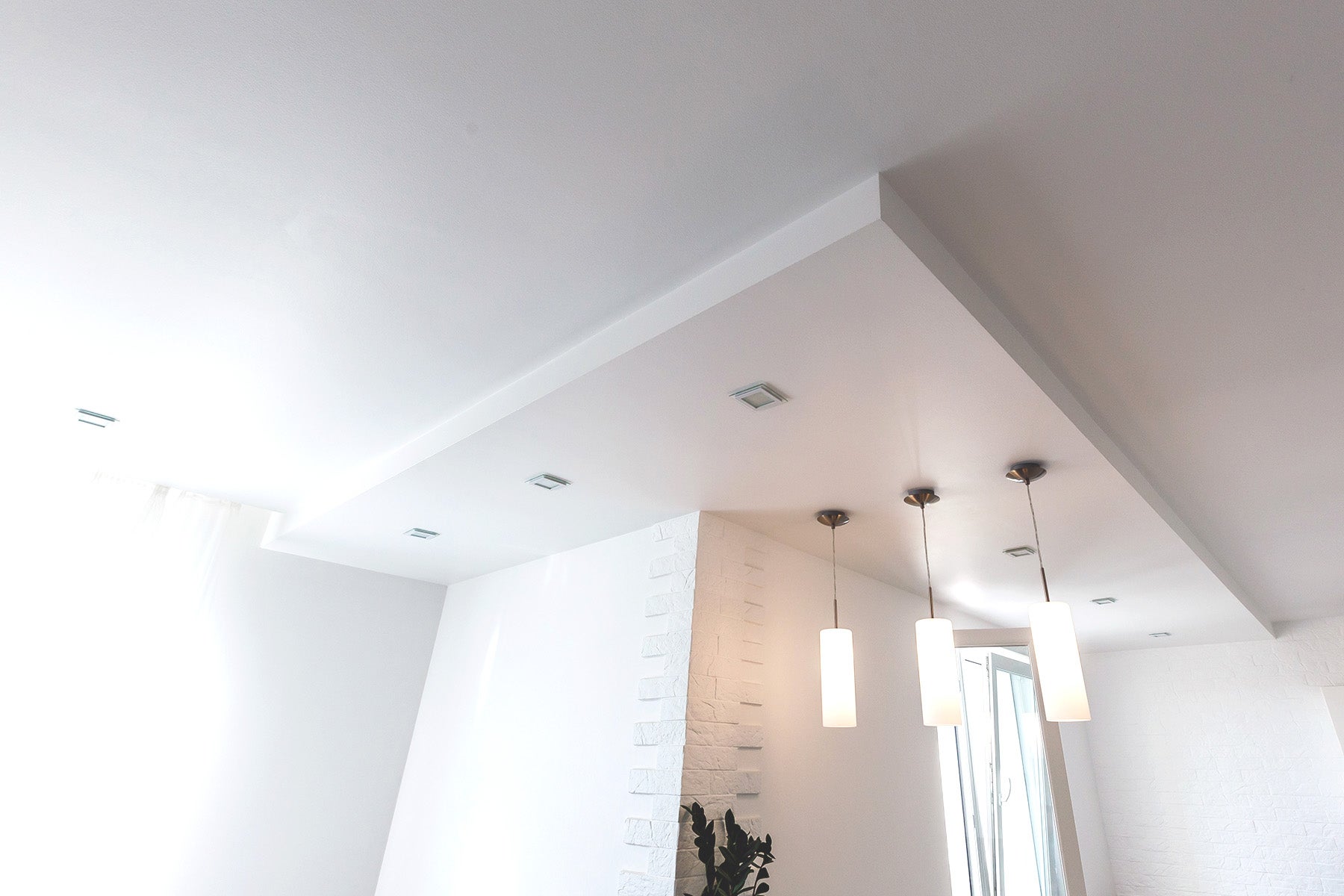October 25, 2024 | Interior Painting
Painting your living room ceiling is a game changer but it’s a messy DIY job
You'll be amazed at the impact a freshly painted living room ceiling can have. It can open up a cramped space, making it feel larger, or transform an outdated room into a modern, refreshed area.
Painting a ceiling is a task many DIYers dread—it's awkward, physically demanding, and can get messy, especially with popcorn ceilings.
Before deciding whether to tackle it yourself or hire professionals, it’s important to understand what goes into painting your living room ceiling the right way.
We’ve painted countless ceilings, and unlike other painters, WOW 1 DAY PAINTING has processes to make sure you get the smooth ceiling paint job you want, in a timeline that’s unexpected..
Is it worth repainting my ceiling?
Repainting your ceiling is a great way to enhance a room's ambiance and cover up imperfections. While it can be time-consuming and costly, it’s worth the investment if you're looking to refresh the space and are prepared to put in the time and effort.
What should I use to clean walls before painting?
Here's our quick and easy guide to get your walls squeaky clean and ready for their makeover:
How often to paint your ceiling:
- Average residential use: 5-7 years
- High-traffic areas: 3-5 years
- Moisture-prone areas: 2-4 years
- Visible stains or damage: Repaint as needed
- Color change: Anytime you want!
What kind of paint do you use on a living room ceiling?
Using a flat (matte) finish paint helps minimize reflections and does a better job of hiding imperfections like patches or uneven surfaces compared to other finishes.
Latex paints, or water-based paints, are easier to apply, dry faster between coats, and have a low odor. They're also more sustainable and easier to clean up in case of accidents. Ceiling-specific paints are designed to cover faint stains and are less likely to drip, making them ideal for overhead surfaces.

Should I paint my ceiling eggshell or flat?
Ceilings are typically painted with a flat finish. For even better coverage, look for an "ultra-matte" finish.
Most people prefer their ceilings to blend in rather than stand out, and using flat paint helps achieve that by reducing light reflection. However, if you're looking to make a statement or highlight historic details, consider using a paint with more sheen or even hand-painting specific elements for added emphasis."
How to paint a living room ceiling
Here are the steps we follow to help you paint like a professional.
- Prep. Ensure the ceiling has been patched, sanded, cleaned and dried for a smooth finish.
- Protect. Painting the ceiling can be a messy task, with the potential to drip paint onto walls, floors, furniture, and windows. It’s essential to use drop cloths and tape thoroughly to protect your space. Don’t forget to wear protective goggles to keep paint out of your eyes and off your face.
- Prime. Before painting any walls, it's important to apply primer to protect the surface. This is especially true for popcorn ceilings, which can deteriorate or fall off when exposed to water or water-based latex paints.
- Paint. Painting the ceiling is one of the most disruptive tasks, so if you plan to paint the walls, it’s best to start with the ceiling to avoid damaging the wall paint.
- Clean up. Ceiling paint tends to drip when being rolled on, so clean up as you go. With water-based paint, sometimes it’s easier to wait for the splatters to dry on hard surfaces and chip them away with a putty knife.
Speak now or forever hold your popcorn ceiling
It's easier to scrape off your popcorn ceiling before painting. If you paint first and decide to remove the popcorn ceiling later, you'll need to soak the ceiling in paint remover and scrape off the paint before tackling the popcorn texture. While it's not impossible to remove after painting, it requires more effort and materials, making the process more costly and time-consuming.
Does ceiling paint need primer?
If your ceiling has been previously painted and you’re going from one off-white to another white, you can usually skip primer without much issue.
Some situations where you need to use primer include:
- You’re painting on a raw material
- You're switching from a dark to a light color
- The ceiling has a glossy finish
- The ceiling has imperfections or stains
What is the trick to painting ceilings?
- Ceiling before walls. It’s a lot easier to overshoot with white ceiling paint rather than carefully cut the corner with a brush. Especially with a white ceiling.
- Use ceiling paint, not wall paint. Ceiling paint is specially formulated to drip less than wall paint, making it better suited for overhead surfaces
Use a ceiling roller. If you're working with a stucco or popcorn ceiling, a fluffier paint roller is going to provide you with a more even coverage.
- Don’t cover up issues, fix them. If your ceiling has water or mildew damage, it will show through even the high quality paints. Be sure to correct any moisture issues and prep the area correctly before painting. If you are concerned about moisture, using an oil-based primer can help.
- Use a pole. A sure-fire way to make a long job even longer is by not having the right tools. Using a paint roller with a pole will speed up the process and is much safer than constantly reaching from a step ladder..
- Know when to hire a professional. High ceilings can make painting feel like an extreme sport once ladders and extra-long poles get involved. Save yourself the danger, call the pros!
Best colors to paint your living room ceiling

Design experts recommend the following painting colors for your living room ceiling:
- White: Makes rooms appear brighter and more spacious.
- Soft Cream: Adds warmth without being too bold.
- Light Gray: Complements various color schemes and styles.
- Off-White: Suitable for traditional or rustic spaces.
- Ceiling White: Ideal for creating a clean and airy feel.
Consider the following factors when choosing a ceiling color:
- Room size: Lighter colors make smaller rooms appear larger.
- Natural light: If your room receives plenty of natural light, you can opt for a slightly darker ceiling color if you want.
- Furniture and decor: Choose a ceiling color that complements your furniture and decor.
Ultimately, when you choose a color, you choose the mood of that room. So pick a color that makes you feel how you want to feel in that space!
What is the most popular color for ceiling paint
White and off-white shades are still the most popular color choices for ceiling painting. However, a dark paint color can create a cozy and striking result— a trend we’re seeing with modern designers looking to make a statement.
Are white ceilings still in style?
The benefit of white or off-white ceilings is their timeless appeal. It’s a neutral color that won’t clash with décor, it's likely cohesive with the ceiling colors throughout the house and it helps lighten up the room, which can be really helpful in small or dark spaces..
Ready to paint your ceilings?
Contact WOW 1 DAY PAINTING today online or at 1-800-WOW-1DAY for a free estimate.

